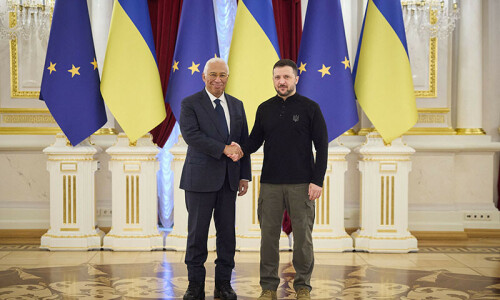In 2021, the Sindh government began demolition work along the Gujjar Nullah, with the idea being that this would pave the way for the expansion of rainwater and sewerage drains. The destruction which ensued led to the annihilation of thousands of homes. Callously declared to be ‘encroachments’, the houses which were torn down resulted in the displacement of thousands of families. Only a handful of those who were impacted by this were provided with monetary compensation, and none of the displaced families were given any alternative housing options.
The wrecking ball of ‘progress’ which apathetically uprooted entire households in the Gujjar Nullah is at the centre of Zahabia Khozema’s exhibition ‘Kya Ye Taraqqi Hai? Tumharey Liye Ya Humarey Liye?’ [Is This Progress? For You Or For Us?].
On display at the VM Art Gallery in Karachi, Khozema’s work shines an empathetic light on the plight of the residents of the Kausar Niazi Colony, a settlement situated along the Gujjar Nullah. The artist uses diverse mediums such as video installations, visual storytelling, poetry, drawing, printmaking and photography to highlight the themes she is grappling with in this exhibition, all of which are impactful in their own way.
One of the most captivating installations at the exhibition is the placement of rows of cement cinder blocks with mutilated steel rods sticking out of them in an ungainly manner, reminding the viewer of the houses that once were. One wonders where the families, which this rubble once provided shelter to, are now living. Do they even have a roof over their head anymore?
Zahabia Khozema’s exhibition is a painful but important reminder of how lives are changed forever in the aftermath of government-enforced demolitions

Khozema’s photos of the Kausar Niazi Colony are eerily quiet. They show decrepit facades and provide a window into what now looks like a ghost town. Her renditions of these spaces on canvas are equally unnerving. In a metropolis that is teeming with people in every alleyway and street corner, Khozema’s mixed media works on canvas — At the Nullah 1 and At the Nullah 2 — depict a side of Karachi which most of us simply do not see, or perhaps choose to ignore.
Khozema’s exhibition, however, is insistent that we cannot overlook the rampant injustices that have crippled Karachi and its people. Her screen prints, What Remains 1, 2, 3 and 4, also show the ruins of the houses and buildings in these settlements at the Gujjar Nullah. However, given Khozema’s choice of colour for these prints, they look like blood-soaked sheets when seen from a distance. As an artist who firmly believes in a multidisciplinary approach, Khozema challenges viewers to consider the relation between the personal and the political, and the collective struggles faced by Karachi’s marginalised communities.
“My work for this show looks at the broken urban infrastructure, the housing crisis and the devastating effects of climate change,” Khozema explains. “Focusing on the demolitions at the Gujjar Nullah, I have explored the idea of development and its consequences, especially in the context of the current economic crisis, political unrest and authoritarian violence that continue to marginalise already vulnerable communities.”
Despite its grim subject matter, or perhaps because of it, it is important for the public to engage with such artworks. These are the realities and challenges facing our city, our country, and they need to be addressed, no matter how uncomfortable or painful the conversation might be.
‘Kya Ye Taraqqi Hai? Tumharey Liye Ya Humarey Liye?’
is on display at the VM Art Gallery,
Karachi from June 12-July 4, 2023.
The writer is an artist and educator
Published in Dawn, EOS, June 25th, 2023














































Dear visitor, the comments section is undergoing an overhaul and will return soon.